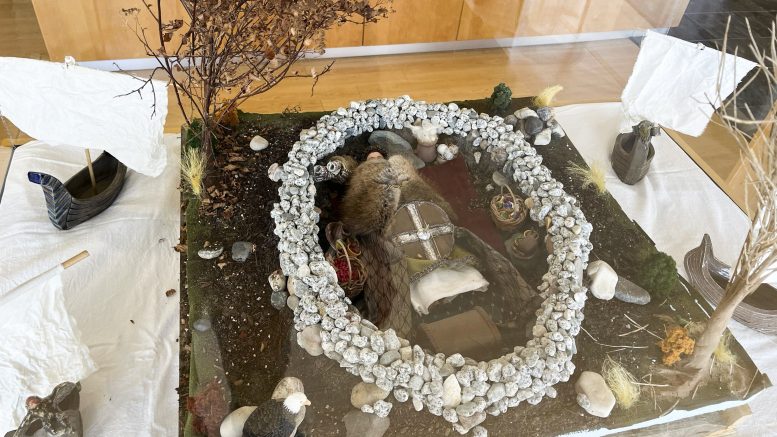The Icelandic Reading Room in the Dafoe Library is a popular study space for students, known for its quiet atmosphere and floor-to-ceiling windows. But have you ever noticed the unsettling art that decorates its interior?
Three dioramas in particular never fail to catch my eye every time I enter the reading room. Intrigued by these striking pieces, I decided to research the characters and stories they depict.
The first is “The Creation of Migard from Ymir the Giant,” a model of a man’s head created by Mackenzie Stewart in 2020. He has long white strands sprouting from his blue skin to form his hair, eyebrows and beard, while his uncomfortably realistic violet eyes stare directly at the viewer. A portion of his skull is removed, revealing trees, a stream and a painted sky inside his head.
In Norse mythology, Ymir was the first being to emerge after the creation of the universe. He is a hermaphroditic giant and an ancestor of Odin, the god of war and death. One day, Odin and his brothers killed Ymir and used his body to form the world — his hair became trees and his skull formed the sky. This landscape became Midgard, the realm of humans.
The second diorama, “Viking Burial,” was also created by Stewart in 2020. It shows a woman lying in a circular cairn, surrounded by various grave goods and flanked by miniature longships. She is dressed in a lavish fur coat, with what appears to be a shield placed on top of her.
Scandinavian Vikings began settling in Iceland in around 800 CE, and burial mounds like this were a characteristic mortuary practice among pre-Christian Norse people. Stewart’s reconstruction vaguely reminds me of the 10th century tomb in Birka, Sweden, which is a famous burial of a female Viking warrior.
The third and most disturbing diorama is untitled and uncredited, and it depicts a man kneeling on an altar with his arm tied to posts beside him. His back is completely flayed open, and his lungs are seemingly folded upwards toward his neck, drenching the altar in blood.
This piece appears to depict the “blood eagle,” a Viking execution method that entails creating “wings” by pulling out the victim’s skin, bones and organs through slits in their backs. The scene is described in the Orkneyinga Saga, in which an earl executes his enemy using this method, dedicating him to Odin as an offering.
The level of detail in these dioramas reflects the immense effort of the artists, bringing these Norse myths and historical practices to life. Together, these three pieces encapsulate the Viking worldview — from the creation of the world to death, and the suffering in between.
The echoes of history and mythology surround us when we take the time to look. Next time you visit your favourite study spot on campus, take a moment to observe your surroundings. What kinds of stories do they tell?
The referenced artwork can be found in the Icelandic Reading Room, which is located on the third floor of the Elizabeth Dafoe Library. It is open from 8:30 a.m. to 4:30 p.m. from Monday to Friday.


